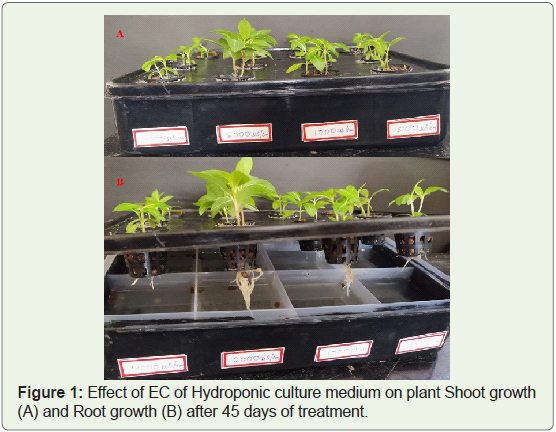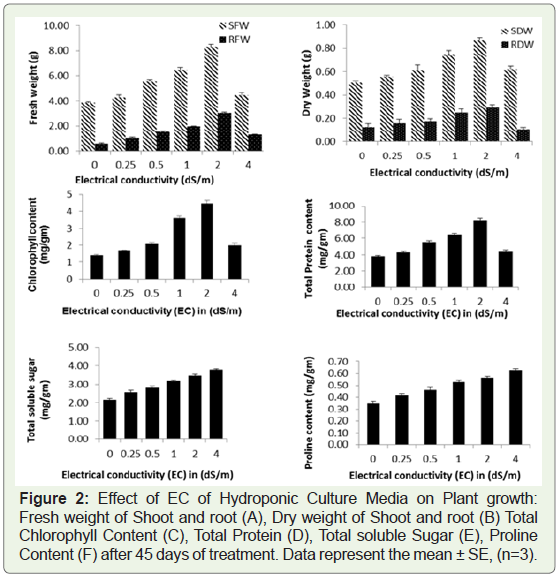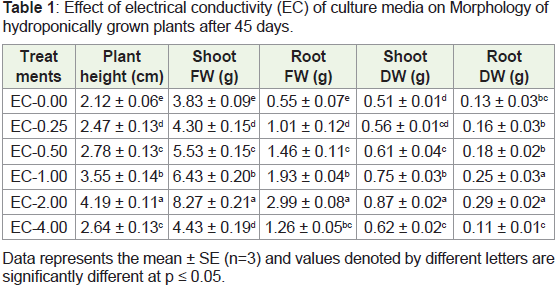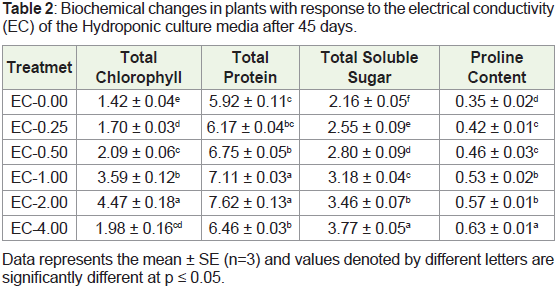Research Article
The Effect of Nutrients Electrical Conductivity on Growth Performance and Biochemical Analysis of Hydroponically Grown Catharanthus roseus (L.) G. DON.
Bhoi GC, Karjee R and Aparajita S*
Department of Botany, Binayak Acharya Government Degree College, Berhampur, Odisha, India
*Corresponding author: Aparajita S, Department of Botany, Binayak Acharya Government Degree College,
Berhampur, Odisha, India; E-mail: saparajita@yahoo.com
Copyright:© Bhoi GC, et al. 2022. This is an open access article distributed under the Creative Commons Attribution License,
which permits unrestricted use, distribution, and reproduction in any medium, provided the original work is properly cited.
Article Information: Submission: 19/09/2022; Accepted: 08/10/2022; Published: 15/10/2022
Abstract
High demand and low synthesis of effective chemotherapeutic agents against cancer harvested from Catharanthus roseus has fostered research for
its increased production. Cellular receptor of plants responds to electrical conductivity (EC) of nutrient media and subsequently causes morphological and
biochemical changes. Optimization of EC in controlled culture media can be used for potential modulation and consequent enhancement of secondary
metabolites in plants. In the current study, effect of EC of nutrient media were studied in Catharanthus roseus through hydroponic system. The results
revealed that plant growth, biomass production, chlorophyll and total soluble protein content gradually increased with increase in EC strength but significantly
decreased at 4.0 dS/m. Accumulation of total soluble sugar and proline considerably increased with the increase in EC strength. Based on the growth
performance and biochemical criteria studied, the optimal EC for growing Catharanthus roseus was found to be 2.0 dS/m which can be further utilized to
enhance secondary metabolites production.
Keywords
Electrical conductivity (EC); Hydroponics; Catharanthus roseus; Terpenoid Indole Alkaloids
Introduction
Catharanthus roseus (L.) G. Don is a perennial, evergreen herb of
the family Apocyanaceae commonly known as periwinkle, Vinca and
as “Sadavahar”. This is native to Madagascar but widely cultivated and
naturalized around south eastern world. The genus consists of two
species categorized as ‘Rosea’ for pink flowered plant and ‘Alba’ for
white flowered plant [1]. Catharanthus is one of the most common
ornamentals plant but also a widely investigated medicinal plant. It is
known to synthesize more than 130different types of terpenoid indole
alkaloids (TIAs) with pharmacological activity [2]. Traditionally
it was used as a hypoglycemic agent but the present interest in this
plant is due to the fact that it is the sole source of chemotherapeutic
agents Vinblastin and Vincristine with powerful anti-cancerous
activities [3]. Apart from this, some other valuable TIAs from C.
roseus are ajmalicine, serpentine used for treating hypertension, heart
arrhythmias, circulatory disorder, cathrenine for treating diabetics.
These plants extensively grown as an annual plant but the content of
terpenoid indole alkaloids (TIAs) are very low. Their effectiveness in
different medicinal treatment, high market value and low synthesis in
nature has fostered research to determine their biosynthesis pathways
to develop alternative production methods. However, the synthesis and
accumulation of secondary metabolites is highly influenced by many
genetic, morphogenic and environmental factor [4]. Environmental
factors such as temperature, humidity, light, water, mineral
concentration and CO2 influence the plant growth and have direct
impact on biochemical pathway affecting the production of secondary
metabolism [3]. For this reason, the application of various abiotic
stresses has become a very promising and cost-effective alternative
solution for elicitation of the secondary metabolites. However, success
can be achieved by establishing a balance between the synthesis of
secondary metabolites of interest and stress metabolites needed by the plants to tolerate the stress [5]. The quality of the plants growing
under natural environment condition is difficult to control as so
many factors influence its ecophysiology and the actual biosynthetic
pathways are difficult to elucidate. For this, there is a necessary to
study ecophysiology of stress response in plants under a controlled
environment condition. Plants are among the few organisms that can
synthesize all the required metabolites from inorganic ions, water and
CO2 using the energy captured from the sun. Hydroponics is a method
of growing plants that takes advantage of this fact by providing all
of the nutrients, in their inorganic form, in a liquid solution [6]. In
this system plants are grown inside enclosures designed to control
air, light, temperature and plant nutrition. Hydroponic systems
have been extensively used by scientists for exploring nutrient
requirements and also the toxicity of some elements in Arabidopsis
and other plant species [7]. In plants nutrients plays a great role in
affecting the physiology, growth and biosynthesis of primary and
secondary metabolites. Inadequate management of nutrient solution
or imbalanced ion composition inhibits plant growth due to nutrient
toxicity or deficiency [8]. In order to provide required strength of
nutrients to plant it is necessary to maintain optimum EC (electrical
conductivity) of nutrient solution. Various kinds of nutrient used are
basically salt when they are dissolved in water it breaks into cation
and anion in the nutrient solution and are capable of conducting
electricity, so a higher concentration of nutrient solution means
greater electrical ions and greater degree of EC.
The objective of the present study was therefore to document
the growth response of Catharanthus roseus to various electrical
conductivity (EC) of the nutrient solution and to analyse the stress
related biochemical changes which can be further utilized to enhance
secondary metabolites production.
Materils & Methods
Plant materials and experimental design:
A cultivar of Catharanthus roseus (L.) G. Don “Alba” was used
for the study. The sterilized seeds of Catharanthus roseus var. “Alba”
obtained from RPRC, Bhubaneswar and were grown in our college
garden. The seeds from the field grown plants were grown in rock
wool cubes (125 cm3) in a cultivation room with photoperiod set to 16
h per day provided by cool white fluorescent lamps. Air temperature
and relative humidity were set to 26oC and 60-80% respectively. When
the seedlings have grown to four leaf stage with fully expanded leaves,
they were transplanted to plastic tanks (22 x 16 x 8cm) containing
nutrient solution with different EC strength. In this study six EC
strength were arranged in a randomized block design with three
replicates. The pH of each treatment solution was adjusted to 6.0. A
portable conductivity meter was used to measure and set different EC
of each nutrient solution tanks. The original nutrient solutions were
based on Hoagland’s solutions. The nutrient solutions with varying
EC were prepared with deionized water and the original Hoagland
nutrient solution. The six different EC treatments includes: EC-0
(contained only single distiled water), EC- 0.25, EC-0.5, EC-1.0, EC-
2.0 and EC- 4.0 (contained original Hoagland solution diluted with
single distiled water to 0.25 dS/m, 0.5 dS/m, 1 dS/m, 2 dS/m and 4
dS/m respectively). After 30 days of culture, the plants from the
culture tanks were harvested and analysed for different growth and
biochemical parameter.Measurement of Plant Growth Parameter: The plants along with
roots were harvested after 45 days of culture from the different EC
treatment. The plant height shoots and root fresh weight (SFW and
RFW) were measured. They were dried in an oven at 600C for 48 hrs
and reweighed for shoot and root dry weight (SDW and RDW).
Biochemical Assay and estimation:
Total Chlorophyll: Total Chlorophyll of leaves was determined
according Arnon’s method for all the EC treatment. 100 mg of leaf
samples were weighed and extracted with 10 mL 85% acetone. The
extract was filtered and analysed using a UV- Vis spectrophotometer
on wavelength of 645nm and 663 nm. The concentration of total
chlorophyll was calculated using the following equation: Total
Chlorophyll: 20.2(A645) + 8.02(A663).Total soluble proteins: Fresh leaves (500 mg) of C. roseus were
harvested from each treatment and homogenised in1mL phosphate
buffer (0.1M, pH-7.0). The protein concentration was determined
following Bradford assay method taking absorbance reading at 595
nm.
Total soluble sugars: Total soluble sugars (TSS) were extracted
from leaves for all EC treatment using the method of Irigoyen et al.,
(1992). A sample of 200mg of leaves were homogenized in 5 mL of
96% ethanol and washed with 5mL of 70% ethanol. The extract was
centrifuged at 3500 x g for 10 min and supernatant was stored at 40C
prior to measurement. Each TSS concentration was determined by
reacting 0.1 mL of the ethanolic extract with 3mL of freshly prepared
anthrone reagent by placing it in a boiling water bath for 10 min. After
cooling absorbance was recorded at 625 nm.
Proline:
Free Proline content was estimated according to the
procedure described by Bates et al., (1973). 50 mg of sample were
homogenized in 10 ml of 3% (v/v) aqueous sulphosalicylic acid and
then the homogenate was filtered. 2 ml of the filtrate was then mixed in
a test tube with 2mL of ninhydrin solution and 2 mL glacial acetic acid
and incubated at 100 0 C for 1 hour. The reaction was than terminated
by placing the mixture in ice bath. When the reaction mixture
cooled, 6 ml of toluene was added and the combination transferred
to a separating funnel. After thorough mixing, the chromophore
containing toluene was separated and the absorbance was read at 520
nm in a spectrophotometer against a toluene blank.Statistical Analysis: Statistical analysis was performed using the
one-way analysis of variance (ANOVA) followed by Duncan’s Multiple
Range Test (DMRT). The values are mean ± SE for three samples in
each group. P values < 0.05 were considered as significant.
Results
Growth and morphology: In studying the effect of different EC
treatment of culture media on Catharanthus roseus, it was observed
that the effect of different level of EC on all parameters under the study
is significant (Figure 1). Plant growth recorded after 45 days of culture
showed clear variations in the different treatment of EC. The overall
plant growth was more in the treatment with EC 2.0 dS/cm than the
plants in other EC treatments. The plant height gradually increases
with the increase in EC of the nutrient solution but was inhibited at
EC 4.0. Stastical analysis revealed that there was significant effect of EC on plant height but the effect was significantly high at 2.0dS/cm
(Table 1). The EC level also affected the total fresh weight of shoot
and root. Statistical analysis indicated that EC had significant effect
on the fresh weight of both shoot and root (SFW and RFW). The plant
grown with EC treatment 2.0 dS/m had highest shoot and root fresh
weight (Figure 2A) and were superior to EC 4.0 dS/m. The different
EC level of nutrients solution affected the shoot and root dry weights
(SDW and RDW) and statistically that were significant (Table 1). The
SDW and RDW grown in EC2.0 had attended higher dry weight but
were statistically same with that of RDW of EC 1.0 dS/m (Figure 2B).
Figure 1: Effect of EC of Hydroponic culture medium on plant Shoot growth
(A) and Root growth (B) after 45 days of treatment.
Figure 2: Effect of EC of Hydroponic Culture Media on Plant growth:
Fresh weight of Shoot and root (A), Dry weight of Shoot and root (B) Total
Chlorophyll Content (C), Total Protein (D), Total soluble Sugar (E), Proline
Content (F) after 45 days of treatment. Data represent the mean ± SE, (n=3).
Table 1: Effect of electrical conductivity (EC) of culture media on Morphology of
hydroponically grown plants after 45 days.
Total Chlorophyll, Total Soluble Protein, Total Soluble Sugar and
Proline Content: The total chlorophyll content gradually increased as
the EC level is increasing. The statistical analysis showed a significant
difference between the different EC treatments (Table 2). The
chlorophyll content reached the highest value in EC 2.0 dS/m and
then decreased significantly at higher EC i.e., 4.0 dS/cm (Figure 2C).
Similarly, the total soluble protein in shoots increases significantly
with the increase from EC 0 to EC 2.0 dS/cm and then decreased
at EC 4.0 treatment (Figure 2D). The Total Soluble sugar content
of leaves increased significantly with increasing EC strength (Table 2). The maximum amount was observed at 4.0 dS/m EC and lowest
was related to the control (Figure 2E). Similarly, the Proline content
varied significantly in different EC treatment. With the increase in the
EC level accumulation of Proline in leaves increased and maximum
Proline content was recorded at 4.0 dS/cm (Table 2, Figure 2F).
Discussion
Increasing EC level causes a significant increase in plant height,
fresh weight and dry weight of both root and shoots up to 2.0 dS/m.
The increase in EC is due to the increase in the concentration of
nutrients and elements which are important for plant growth and
development. So with the increase in the concentration of the
nutrient there is an increase the growth parameter of Catharanthus
roseus. The highest EC treatment EC 4.0 dS/m shows a significant
decrease in growth parameter which may be due to the toxic effect
of high nutrient concentration in solution [9-11]. Albornoz and
Lieth (2015) found that increase in EC at root zone reduces the yield
of lettuce due combined effect of decrease leaf area and stomatal
conductance [4]. Increase in EC above 2.0 dS/m increases salinity
of the medium and causes water stress which may have caused the
reduction of turgor pressure within cell and restricted cell expansion
[12,13]. Osmotic effect, nutritional deficiency on account of ionic
imbalance and decrease in many metabolic activities due to high EC
reduces water absorption by root that attributes to the reduction in
plant growth [14-16]. Similar results were observed by various author where increase in concentration of nutrients in medium leads to water
deficits and reduction of vegetative characters [5,15]. The uneven
supply of nutrient concentrations considerably affects physiological
process of the plants. In our present study we found that the total
chlorophyll content was relatively low in low EC treatments which
may be probably due to low nutrient concentration and deficiency
of nutrient such as N, Mg and Fe that are important for chlorophyll
biosynthesis. There is a gradual and significant increase in chlorophyll
content with the increasing EC treatment with respect to control.
But at EC treatment of 4.0 dS/m the chlorophyll content decreases
which could be associated with the accumulation of Na+ in leaves
and decreased pigmentation concentration [2]. Conversely, it has
been reported by many authors that there is an increase of chlorophyll
content with increase in EC above 2.0dS/m [11,17-26]. Total protein
content determines the nitrogen content of a plant. In this study the
total protein increased with increase in EC due to availability of more
nitrogen element. There is an increase in protein content of plants in
EC treatment up to 2.0 dS/m which is similar to results reported for
Pakchoi and Corn [11,21]. At higher EC treatment of 4.0 dS/m the
protein content in Catharanthus decreases. It may be suggested that
nitrogen and carbon containing compound plays an important role
during stress as osmotic adjustment (Misra and Gupta, 2006). So,
there is a reduction of protein content at higher EC treatment of 4.0
dS/m as the nitrogen and carbon will be used as osmotic adjustment.
On the other hand, there is a significant increase in the level of Proline
in our present study with the increasing EC strength. For maintaining
the ionic balance in vacuoles, cytoplasm accumulates low molecular
weight compatible solute which does not interfere with normal
biochemical reaction by replacing water in biochemical reaction
(Ahmad and john, 2005). Several authors have suggested strong
correlation between cellular Proline level and the capacity to survive
different environmental stress [7,19,22]. Increased level of proline
has also been recorded to correlate with enhanced tolerance to water
deficient stress in Catharanthus roseus [2]. Proline and it intermediates
helps in the regulation of stress responsive gene (Khedret al., 2003)
and enhanced expression of osmoregulatory gene [24]. Moreover,
Proline was reported to function as radical scavenger, electronic sink,
stabilizer of macromolecules and a cell wall component [18]. There is
a significant increase in the total soluble sugar content with increasing
EC strength. Similar results were reported by Amalfitano et al., (2017)
in ‘Friariello’ pepper fruit and Ramezani (2011) in Echium amoenum
[27-29]. Accumulation of soluble sugars in response to the increasing
environmental stress has been widely reported despite specific
reduction in net CO2 assimilation level [9,19]. Sugar in addition to
the role of regulating osmotic balance acts as metabolic signals in the
stress condition.
Conclusion
Effect of different EC treatments on Catharanthus roseus culture
grown hydroponically were shown better growth in EC strength of
2.0 dS/m as evident from increased morphological and biochemical
parameters. Too low EC strength limits plant growth while high EC
strength is inhibiting growth because of salinity stress. Considerable
increase in accumulation of proline and soluble sugar in higher EC
also indicates stress tolerance capacity of the plant, which will be
helpful for monitoring the elicitation of secondary metabolites.
Acknowledgment
The authors would like to acknowledge Odisha State Higher
Education Council (OSHEC), Govt. Of Odisha for financial support
through OURIIP scheme. The authors would like to thank Principal
Binayak Acharya College and Head of Botany Department for proving
logistic and research facilities for successful execution of research project.




